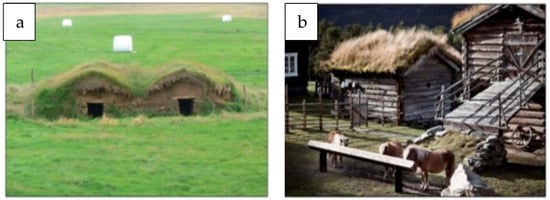You're using an outdated browser. Please upgrade to a modern browser for the best experience.
Please note this is a comparison between Version 1 by Flavia Bartoli and Version 2 by Sirius Huang.
Extensive Green Roofs (EGRs) are nature-based solutions that provide several environmental, health, social, and economic benefits. This synthresisview of about 1430 scientific papers, based on the five Ws, When, Where, Why, Who, and Which, aims to understand how interest in these important green infrastructures originated and developed, as well as the nature of such academic research. Special attention was paid to the way researchers approached plant selection.
- roof greening
- urban ecology
- biodiversity
- urban planning
- sustainable development
1. Introduction
The growth of urbanization in developed and developing countries is one of the most important social and economic phenomena in the overall development of different aspects of human life [1]. However, urban ecosystems are where interactions between anthropogenic activities and the natural environment are at their most intense [2][3][2,3]. Over the years, the expansion of cities has led not only to a reduction in green areas but also to greater environmental damage from the production of heat, waste, water, and air pollution and has generally had a negative impact on biodiversity [4][5][6][7][8][4,5,6,7,8]. There is an urgent need for integrative planning of green cities if we are to meet the growing environmental, social, and economic challenges posed by the negative effects of urban development [9]. Cities of the future should strive to be greener by designing and managing green infrastructure that can improve urban resilience and livability [10][11][10,11]. Even though urban forests and green open spaces in cities (tree-lined streets, gardens, parks, wetlands) are essential, there is often limited availability of ground-level spaces suitable for nature-based solutions.
Green roofs, typically consisting of vegetation planted above a series of layers that protect the roof substrate and improve the system’s performance, can, therefore, represent an ideal supplementary space [12][13][14][12,13,14]. In particular, extensive green roofs (EGRs) require a shallower growing media and little maintenance compared to intensive green roofs (IGRs), which involve a thicker growing media and more intensive gardening [6].
Vegetated building roofing dates back to at least the Neolithic Era (8000–4000 BC), as they provided protection for buildings in harsh and climatically extreme environments [15]. For example, in the Arctic and the semi-arid continental lands of Central Asia, the scarcity of trees gave rise to a vernacular architecture where roofs were insulated with soil and living grasses from natural meadows (Figure 1a,b), known as “sod-roofs” [16]. The use of vegetation on buildings has also been recorded in the milder climates of medieval and modern Europe, particularly the beautiful, intensive green roofs built by aristocratic families and religious organizations [13]. These architectural structures gained complexity over the years with the invention of reinforced concrete, which allowed the construction of multi-story buildings with wide flat roofs and, as a result, provided many more opportunities for creating ornamental gardens above ground level [16].

Figure 1. Old vegetated building roof (a) Traditional semi-subterranean sod house in Iceland (Photo credit Christian Bickel under Wikimedia Commons at “https://en.wikipedia.org/wiki/Sod_house”. Accessed on 8 December 2023). (b) Traditional log farmhouses with sod roofs in Glittersjaa Mountain, Norway (Photo credit Tina Stafrén and “visitnorway.com”. Accessed on 8 December 2023).
Studies carried out in Germany in the mid-twentieth century stimulated the birth of modern EGRs; thereafter, spontaneous vegetation growth was observed on flat roofs, demonstrating nature’s ability to create green roofs on buildings [13]. Le Corbusier [17] was already talking about green roofs in 1927 and listed them among his ’Five Points of Modern Architecture’, citing their functional benefits in protecting reinforced concrete from temperature changes, as well as their recreational value [18][19][18,19], while in 1936 the roof gardens created in South America by Roberto Burle Marx became famous [20].
Extensive green roofs have been the subject of several review papers and research papers, although these tended to focus on individual aspects [21][22][23][21,22,23]. Such studies have shown how EGRs help mitigate the urban heat island (UHI) effect, reduce temperature through evapotranspiration [12][14][24][12,14,24], and stormwater run-off by retaining water [12][14][25][26][27][12,14,25,26,27]. They absorb air pollution [14][28][14,28] and act as a sound barrier due to the thickness of the substrate and vegetation layers [29][30][29,30]. Green roofs also provide ecological benefits by supporting urban flora and fauna biodiversity and functioning as ecological corridors [6][31][32][33][34][6,31,32,33,34]. Finally, some revision work highlights how green roofs can affect different types of ecosystem services [35][36][35,36].
Although the historical and geographical background seems quite clear, interest in this topic has lacked consistency and homogeneity both in chronological and geographical terms. The same can be said for the themes chosen for study; although the spectrum of topics is very broad, interest in addressing them is not homogeneous. There is still a need for a more detailed analysis of ‘where and when’ interest in modern green roofs spread in the context of scientific research and ‘why’, i.e., with what goal such studies were made. Additionally, green roofs may be of interest to a wide range of disciplines, particularly engineering, architecture, agronomy, and botany. Another interesting question in need of clarification is ‘who’, i.e., the professional background of the study authors.
The botanical aspect of green roofs and their design, on the other hand, tends to be neglected, with little attention paid to plant selection. Although plant species play an important aesthetic role, which is a crucial architectural priority and important for psychological well-being [8][37][8,37], the plants selected are also fundamental to the functionality of green roofs. For this reason, care should be taken to select the most appropriate plant species [6][38][6,38], and attention must be paid to the influence that soil depth, local climates, water availability, and planting density have on roof-based plants [19][39][40][41][19,39,40,41].
